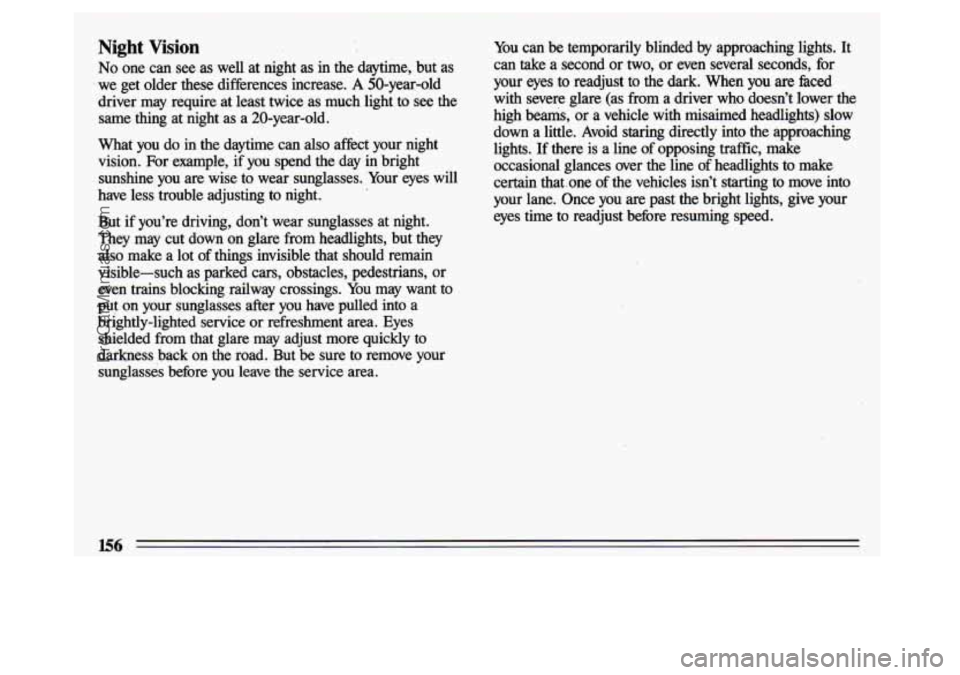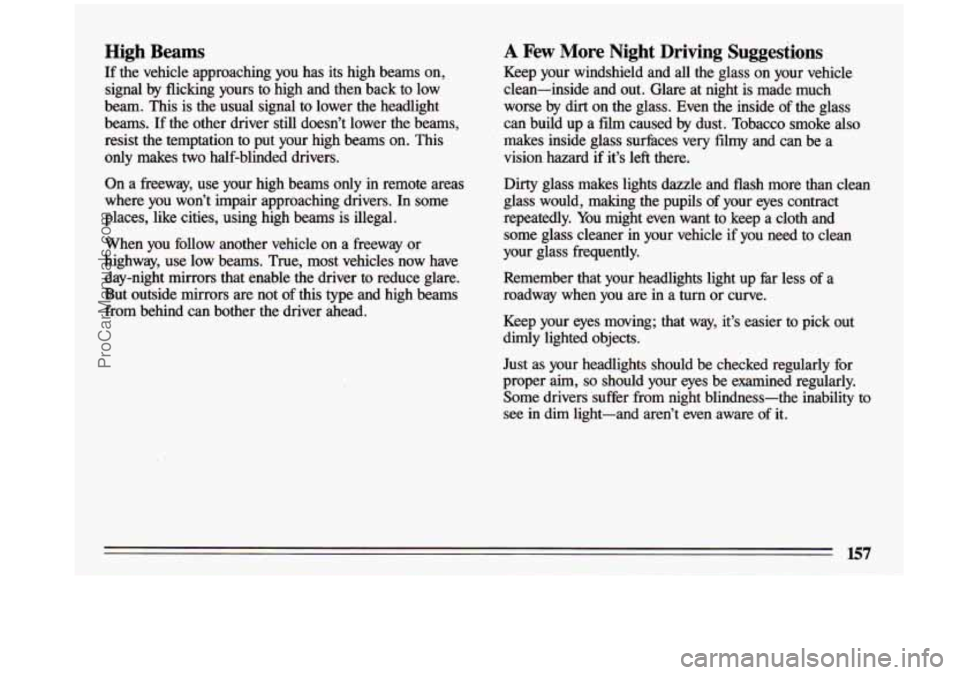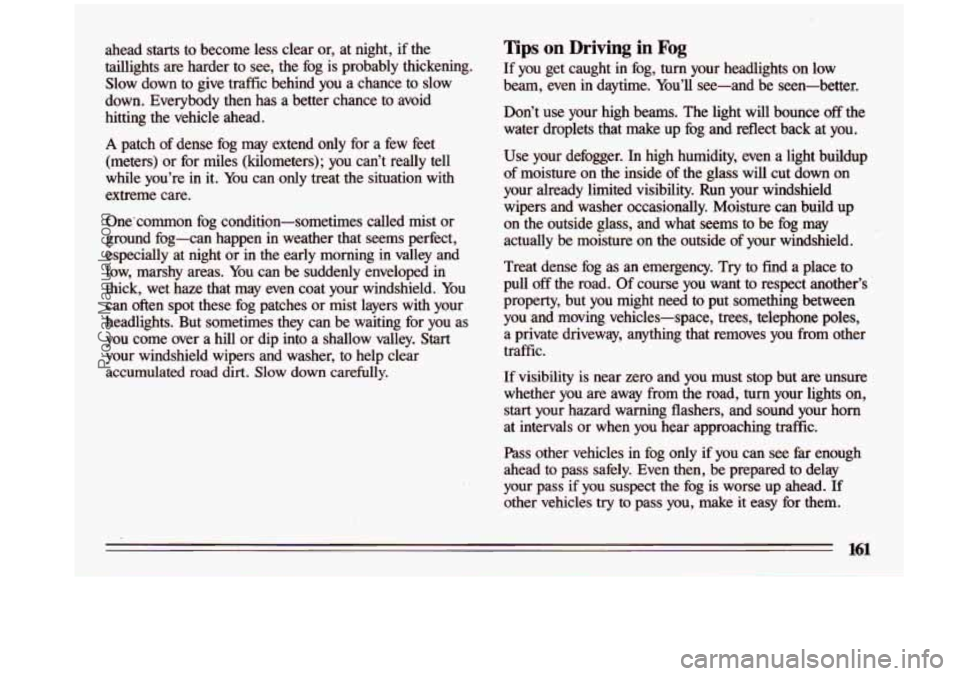1993 BUICK CENTURY high beam
[x] Cancel search: high beamPage 14 of 324

I
Vehicle Symbols
These are some of the symbols you will find on your vehicle.
For example,
these symbols
are used on an
original battery:
POSSIBLE A
CAUTION
INJURY
PROTECT EYES BY
SHIELDING
CAUSTIC
ACID COULD CAUSE
BATTERY
BURNS AVOID
SPARKS
OR
FLAMES
SPARK
OR ,111,
COULD FLAME
EXPLODE BATTERY
These symbols
are important
for. you and
your passengers
whenever your
vehicle
is
driven:
DOOR LOCK
UNLOCK
FASTEN SEAT
4
BELTS
POWER
WINDOW
These symbols
have
to do with
your lights:
SIGNALS e3
TURN
WARNING
A
HAZARD
FLASHER
HIGH BEAM
OR =, =o
FOG LAMPS # 0
These symbols
are on some
of
your controls:
WINDSHIELD ' ' ' 0- 0-
WIPER &
WASHER
t0 @e4 i
WINDSHIELD=
WASHER I
wlNDsHIELDw DEFROSTER
WINDOW
@
REAR
DEFOGGER
VENTILATING FAN
HEADLAMP
-
WIPER -
WASHER zQ
Thes, ,ymbols
are used on
warning and indicator lights:
COOLANT F-
ENGINE
TEMP
--
CHARGING I-1
BATTERY SYSTEM
FUEL
ENGINE OIL wb
PRESSURE
TEMP
OIL &
ANTILOCK BRAKE (i)
Here are some
other symbols
you may see:
FUSE
RADIO
k
VOLUME a
CONDITIONING AIR a
HATCHBACK e
TRUNK
RELEASE
SPEAKER
b
ProCarManuals.com
Page 88 of 324

Horn
You can sound the horn by pressing the horn symbol on
your steering wheel.
Tilt Steering Wheel (Option)
b
-.
A tilt steering wheel allows
you
to adjust the steering
wheel before you drive. You
can
also raise it to the
highest level
to give your
legs more room when you
exit and enter the vehicle.
To tilt the wheel, hold the
steering wheel and pull the
lever. Move the steering
wheel to a comfortable
level, then release the lever
to lock the wheel in place.
The I’urn SignaUHeadlight Beam
Lever
The lever on the left side of the steering column includes
your:
Turn Signal and Lane Change Indicator
Headlight High-Low Beam
Windshield Wipers
Windshield Washer
Cruise Control (Option)
86
ProCarManuals.com
Page 90 of 324

Headlight Highhw Beam Windshield Wipers
To change the headlights
from low beam to high, or
high to low, pull the
turn
signal lever all the way
toward
you. Then release
it. When the high beams
are on,
.this blue light on
the instrument panel also will be on.
i
I
You control the windshield wipers by turging the band
marked
“WIPERI’
For a single wiping cycle, turn the band to “MIST? Hold it there until the wipers
start, then let go. The wipers will
stop after one cycle.
If you want more cycles, hold the
band on “MIST” longer.
For steady wiping at low speed,
turn the band away from
YOU to the “LO” position. For high speed wiping, turn
the band further, to “HI? To stop the wipers, move the
band to “OFF?
88 .I
ProCarManuals.com
Page 97 of 324

Lights
Interior Lights/Instrument Panel Intensity Control
I+
Headlights
*P
I PF
You can brighten or dim the
instrument panel lights by
rotating the control up or
down. To turn on the
interior courtesy lights,
rotate the control all the
way up to
“HI:’
Press the switch marked “P” to
turn on:
Parking Lights
Side Marker Lights
Taillights
License Plate Lights
Instrument Panel Lights
-‘(J- Press the , switch to turn on the headlights,
together with:
Parking Lights
Side Marker Lights
Taillights
License Plate Lights
Instrument Panel Lights
Press
“OFF” to turn off the lights.
Operation of Lights
Although your vehicle’s lighting system (headlamps,
parking lamps, fog lamps, side marker lamps’and tail
lamps) meets
all applicable federal lighting requirements,
certain States and Provinces may apply their own lighting
regulations that may require special attention before you
operate these lamps. For example, some jurisdictions
may require that you operate your lower beam lamps
with fog lamps at
all times, or that headlamps be turned
on whenever you must use your windshield wipers.
In
addition, most jurisdictions prohibit driving solely with
parking lamps, especially at dawn or dusk.
It is
recommended that you check with your own State Or
Provincial highway authority for applicable lighting
regulations.
95
ProCarManuals.com
Page 158 of 324

Night Vision
No one can see as well at night as in the daytime, but as
we get older these differences increase. A 50-year-old
driver may require at least twice as much light to
see the
same thing at night as a 20-year-old.
What you do in the daytime can also afkct your night
vision. For example, if you spend the day in bright
sunshine you are wise to wear sunglasses. Your eyes will
have less trouble adjusting to night.
But if you’re driving, don’t wear sunglasses at night.
They may cut down on glare from headlights, but they
also make a lot of things invisible that should remain
visible-such as parked cars, obstacles, pedestrians, or
even trains blocking railway crossings. You may want to
put on your sunglasses after you have pulled into a
brightly-lighted service or refreshment area. Eyes
shielded from that glare may adjust more quickly to
darkness back on the road. But be sure to remove your
sunglasses before you leave the service area.
You can be temporarily blinded by approaching lights. It
can take
a second or two, or even several seconds, for
your eyes to readjust to the dark. When you
are hced
with severe glare (as from a driver who doesn’t lower the \
high beams, or a vehicle with
misaimed headlights) slow
down a little. Avoid staring directly into the approaching
lights. If there
is a line of opposing traffic, make
occasional glances over the line of headlights to make
certain that. one of the vehicles isn’t starting to move
into
your lane. Once you are past the bright lights, give your
eyes time to readjust before resuming
speed.
156
ProCarManuals.com
Page 159 of 324

High Beams
If the vehicle approaching you has its high beams on,
signal by flicking yours to high and then back to low
beam. This is the usual signal to lower the headlight
beams. If the other driver still doesn’t lower the beams,
resist the temptation to put your high beams on. This
only makes two half-blinded drivers.
On a freeway, use your high beams
only in remote areas
where you won’t impair approaching drivers.
In some
places, like cities, using high beams is illegal.
When you follow another vehicle on a freeway or
highway, use low beams. True, most vehicles now have
day-night mirrors that enable the driver to reduce glare.
But outside mirrors are not
of this type and high beams
from behind can bother the driver ahead.
A Few More Night Driving Suggestions
Keep your windshield and all the glass on your vehicle
clean-inside and out. Glare at night is made much
worse by dirt on the glass. Even the inside of the glass
can build up
a fdm caused by dust. Tobacco smoke also
makes inside glass surfaces very filmy and can be a
vision hazard
if it’s left there.
Dirty glass makes lights dazzle and flash more than clean
glass would, making the pupils
of your eyes contract
repeatedly. You might even want to keep a cloth and
some glass cleaner in your vehicle if you need to clean
your glass frequently.
Remember that your headlights light up
fhr less of a
roadway when you are in a turn or curve.
Keep your eyes moving; that way, it’s easier to pick out
dimly lighted objects.
Just as your headlights should be checked regularly for
proper aim,
so should your eyes be examined regularly.
Some drivers suffer from night blindness-the inability to
see in dim light-and aren’t even aware of it.
ProCarManuals.com
Page 163 of 324

ahead starts to become less clear or, at night, if the
taillights are harder to see, the fog is probably thickening.
Slow down to give traffic behind you a chance to slow
down. Everybody then has a better chance to avoid hitting the vehicle ahead.
A patch of dense fog may extend only for a few feet
(meters) or for miles (kilometers); you can’t really tell
while you’re in it. You can only treat the situation with
extreme care.
One‘common fog condition-sometimes called mist or
ground fog-can happen in weather that seems perfect,
especially at night or
in the early morning in valley and
low, marshy areas. You can be suddenly enveloped in
thick, wet haze that may even coat your windshield. You
can often spot these fog patches or mist layers with your
headlights. But sometimes they can be waiting for you as
you come over a hill or dip into a shallow valley.
Start
your windshield wipers and washer, to help clear
accumulated
road dirt. Slow down carefully.
Tips on Driving in Fog
If you get caught in fog, turn your headlights on low
beam, even in daytime. You’ll see-and be seen-better.
Don’t use your high beams. The light will bounce
off the
water droplets that make up fog and reflect back at you.
Use your defogger. In high humidity, even a light buildup
of moisture on the inside of the glass will cut down on
your already limited visibility. Run your windshield
wipers and washer occasionally. Moisture can build up
on the outside glass, and what seems to be fog .may
actually be moisture on the outside
of your windshield.
Treat dense fog as an emergency.
Try to find a place to
pull off the road. Of course you want to respect another’s
property, but you might need to put something between
you and moving vehicles-space, trees, telephone poles,
a private driveway, anything that removes you from other
traffic.
If visibility is near zero and you must stop but
are unsure
whether you are away from the road, turn your lights on,
start your hazard warning flashers, and sound your horn
at intervals or when you hear approaching traffic.
Pass other vehicles in fog only if you can see far enough
ahead to pass safely. Even then, be prepared
to delay
your pass if you suspect the fog is worse up ahead.
If
other vehicles try to pass you, make it easy for them.
161
ProCarManuals.com
Page 271 of 324

Century Dimensions
Inches unless otherwise noted .
Overall: COUPE SEDAN WAGON
Length ................
. Width .................
Height ................
Wheelbase .............
Front Tread ............
Rear Tread .............
Interior Front:
Leg Room
.............
Head Room ............
Shoulder Room .........
Hip Room ..............
Interior Rear:
Leg Room .............
Head Room ............
Shoulder Room .........
Hip Room ..............
Tzvnk Capacity-Cubic Feet
Number of Passengers:
Front .................
Rear ..................
Rear-Facing Third Seat ...
Base Curb Weight--Po unds 189.1
69.4 53.7
104.9 58.7
56.7
42.1 38.6
55.8
50.2
35.9
38.3
57
. 0
53.6
16.2
3
3
.
2862 189.1
69.4
54.2
104.9 58.7
56.7 190.9
69.4
54.2
104.9 58.7
56.7
42.1 42.1
38.6 38.6
55.9 55.9
50.0 50.0
35.9
38.3
56.0
54.3
16.2
3
3
.
2914 34.8
38.9
56.0
54.3
41.6
3
3
2
3054
Replacement Bulbs
APPLICATION NUMBER
Exterior
Headlight High Beam
........................
Low Beam .........................
ParW Turn ...........................
Side Marker ....... .................
Backup .............................
High Level Stop (w/o luggage carrier) .....
High Level Stop (w/luggage carrier) .......
License .............................
Side Marker .........................
Tail/Stop ............................
Tail/Stop/Turn .........................
Underhood ..........................
9005
9006
2057 194
1156
1141
577 194
194
194
2057
561
Interior
Ashtray ............................. 194
Door Courtesy
....................... 214-2
Dome
.............................. 211-2
Front Reading
........................ 906
Glove Box ............................ 194
Map
............................... 168
Rear Dome (Wagon)
................... 211-2
Trunk
.............................. 1003
Vanity Mirror ........................ 124
269
.
ProCarManuals.com